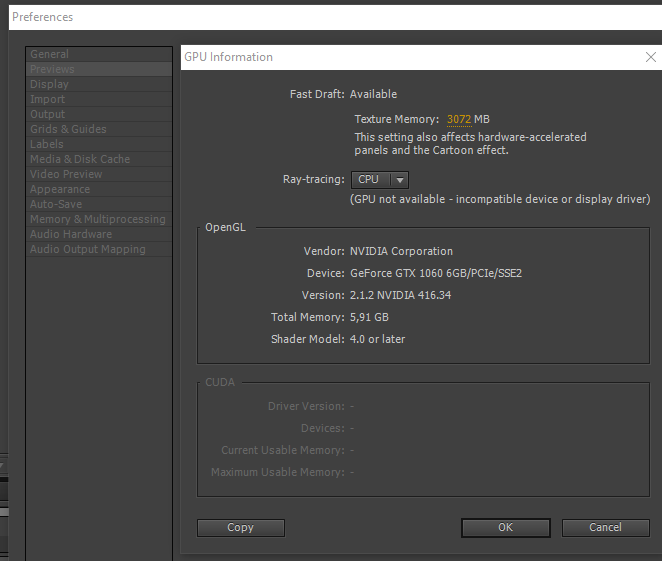- Home
- After Effects
- Discussions
- How to enable ray-tracing GPU support in AE CS6?
- How to enable ray-tracing GPU support in AE CS6?
Copy link to clipboard
Copied
I have the After Effects CS6 with the latest updates (v11.0.4.2) installed on my Windows 10 Pro PC. My processor is an AMD Ryzen 5 1600X, the GPU is an NVIDIA GeForce GTX 1060 (6GB RAM edition) with 1280 CUDA cores, OpenGL 4.5, VulkanAPI und DirectX 12.1. I have the latest NVIDIA WHQL driver 416.34 (from 2018-10-11).
This GPU works well with After Effects CS4, but After Effects CS6 refuses to active it ("GPU not available - incompatible device or display driver").

I also tried the CUDA Toolkit, which is usually required only for development of CUDA applications, not for the runtime.
However, I did not managed to get the GPU working with CS6. Do anyone have tips?
Edit: Photoshop CS6, Encore CS6 and Lightroom 6 are accepting the GPU for acceleration.
 1 Correct answer
1 Correct answer
The Ray Traced renderer is End of Life and no longer being developed - hence support for recent graphics cards has not been provided. The Cinema 4D renderer is the recommended current option. However, it is possible to work around this situation - at your own risk, and unsupported of course. Here are some detailed instructions:
NB: If you do replace the optix.dll file I would strongly
...Copy link to clipboard
Copied
The Ray Traced renderer is End of Life and no longer being developed - hence support for recent graphics cards has not been provided. The Cinema 4D renderer is the recommended current option. However, it is possible to work around this situation - at your own risk, and unsupported of course. Here are some detailed instructions:
NB: If you do replace the optix.dll file I would strongly advise you to keep a copy of the original (I would rename it with a _xxx suffix) should you wish to revert.
Copy link to clipboard
Copied
Mike_Abbott wrote
However, it is possible to work around this situation - at your own risk, and unsupported of course. Here are some detailed instructions:
NB: If you do replace the optix.dll file I would strongly advise you to keep a copy of the original (I would rename it with a _xxx suffix) should you wish to revert.
Hi Mike.
Thank you for the tip! It worked with my GeForce 1060 with the string "GeForce GTX 1060 6GB". Took some tries to figure it out.
However, strange that a 2 year older edition (CS4) works and a much "recent" edition (CS6) don't right out of stock. I see that the CS6 implementation checks for known GPU identification strings...
Copy link to clipboard
Copied
The ray-traced renderer was introduced in CS6. What are you using in CS4 that you are saying works better?
Copy link to clipboard
Copied
When I disable GPU acceleration in CS4 it is slow, when I enable it it is fast. Maybe it's not ray-tracing but overall.
Copy link to clipboard
Copied
@Mike_Abbot
Saw this post in a few other places, about the Ray Tracing renderer being removed by Adobe, but couldn't find anything directly from Adobe about it's removal, just people in the forums saying it was going to be removed. Also, the 1060 series of graphics cards support live ray tracing in games on PC. As of a few weeks ago, there currently weren't any games out that supported live ray tracing while you play, but there will be within the next few months. Lastly, Hollywood uses Ray Tracing all the time, it's the reason the gaming industry adopted it. It allows for light to bounce and gleam and shine off of CG things just like it would in real life. Can you explain or give more insight as to what's going on. Sorry to post off-topic, just want to know what's going on. Thanks! ![]()
Copy link to clipboard
Copied
Adobe doesn't have a habit of putting out definitive statements about features they're going to abandon - particularly things that were hyped as the latest and greatest when they were introduced just a couple of years earlier : )
Nevertheless, there were various statements from Todd Kopriva (the AE product manager at the time) including IIRC : "It's dead to us..." and you can also see some further comments from him here:
warning that the GPU accelerated ray-traced 3D renderer does not have enough free memory to operate
The fact that they've just left the feature to rot over the last 4 years might also tell you something.
I think it's a pity actually - I wish it was still under development myself...
Re your other general comments above:
I think you're actually referring to the new generation 20 series cards that have RTX ray tracing fuctionality. Yes, RT can be very useful - I do lot of 3D ray traced CGI work myself. But integrating and benefiting from these technologies requires a lot of development work on the host software as well. The RTX features are also Nvidia only of course.
Get ready! An upgraded Adobe Community experience is coming in January.
Learn more